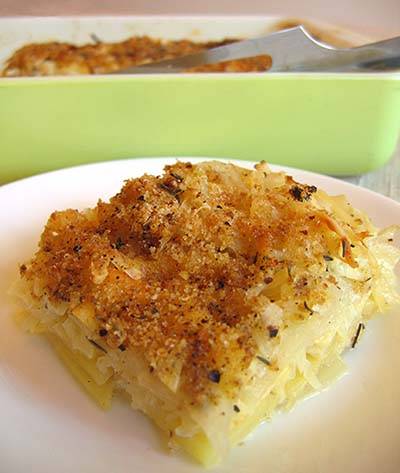 Growing up in the Midwest there was always the red plaid cookbook and the red cookbook; my mom had them, my friends’ moms had them, their moms’ friends had them. So, it comes as little wonder that potlucks and get-togethers were repeatedly plagued by the same bad potatoes au gratin.
Growing up in the Midwest there was always the red plaid cookbook and the red cookbook; my mom had them, my friends’ moms had them, their moms’ friends had them. So, it comes as little wonder that potlucks and get-togethers were repeatedly plagued by the same bad potatoes au gratin.
Potatoes au gratin was never meant to be a casserole to feed the masses. Because the authors of these cookbooks mistakenly thought it should be, invariably what showed up at these events were vats of semi-raw potato slabs floating in wannabe cheese sauce.
This gave gratins a bad name and at some level you have to wonder if it didn’t pave the way for the red cookbook people to sell boxed potatoes au gratin as the red spoon people.
Gratins aren’t rocket science; they originated as simple, homey dishes to use up leftovers or deal with a pound or two of something that was in season. Gratins can be savory or sweet, creamy or dairy-free. The only common denominator is that the components are placed in a shallow dish with some sort of fat-milk, cream, butter, and/or olive oil. The mixture is then topped with bread crumbs, grated cheese, or cookie crumbs, which crisps as the dish is baked or broiled.
Jacques Pepin, who is a master at turning leftovers into fine dining, combines bread cubes, cherry tomatoes, a healthy drizzle of olive oil, salt, pepper, and several tablespoons of grated parmesan in a bowl. He then pours the works into a shallow dish coated with olive oil, sprinkles on a bit more cheese, and bakes it until the bread is toasted. Pepin also makes gratins from things in his pantry like frozen raspberries and shortbread cookies.
Of course my vegetable bin is a scary place compared to Pepin’s pantry. This weekend it was harboring a pale cabbage that was attempting to grow a mini-me, several kohlrabies that were several weeks old, and a few potatoes.
Even an ingredient list as disjointed as this is fine for a gratin as long as you take into account different rates of absorption. Thinly sliced potatoes can be placed in a gratin uncooked as they absorb liquid easily. Sturdier ingredients like parsnips, Jerusalem artichokes, kohlrabi, and celery root must be pre-cooked or they will be crunchy instead of creamy in the final dish. I typically poach everything just to ensure no childhood gratin disaster repeats.
For best results, you’ll want to slice the vegetables 1/8 inch thick or thinner. I like to use a mandolin for this task. If you don’t have one, you can get a Benriner mandolin for less than $20 at most of the local Asian groceries.
If you are adding greens like cabbage or kale, blanch and drain them thoroughly so the final dish isn’t watery. Blanching also will bring out the green’s sweetness.
Cabbage, Kohlrabi and Potato Gratin
- 1/2 pound of thinly sliced cabbage (can substitute kale)
- 1/2 pound of peeled waxy potatoes like Yukon Gold, Red Bliss, Red Norland
- 1/2 pound of peeled kohlrabi
- 1 thinly sliced large onion
- 2 cloves garlic, thinly sliced
- generous pinch of thyme
- salt
- 2 c. whole milk
- 1-2 cups grated flavorful cheese like gruyere, Parmesan
- grated nutmeg
- freshly ground pepper
- 3 T cream or 1 T butter cut into small pieces
- 3 T bread crumbs
Preheat the oven to 375 degrees F. Put the kohlrabi slices in a 2-quart pot with the milk, herbs, onion, garlic, thyme and 1 t of salt. Slowly bring to a boil, then simmer. Meanwhile, in a separate pan, blanch cabbage and drain thoroughly. When kohlrabi is soft but not falling apart, remove it and onions with a slotted spoon. Place potato slices in remaining liquid and simmer until just tender but not falling apart. Drain, saving the liquid.
Butter a rectangular casserole dish. Alternate layers of kohlrabi, potato, and cabbage, sprinkling with cheese, pepper, and nutmeg in between. Pour poaching liquid over top. Sprinkle top with cheese, pepper, and nutmeg. Drizzle with cream or dot with butter. Sprinkle on bread crumbs. Bake about 1 hour or until a golden crust has formed and vegetables are creamy.








